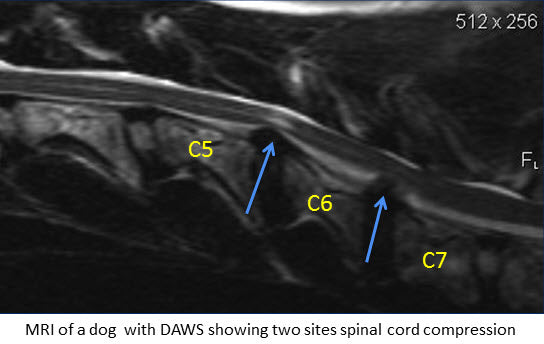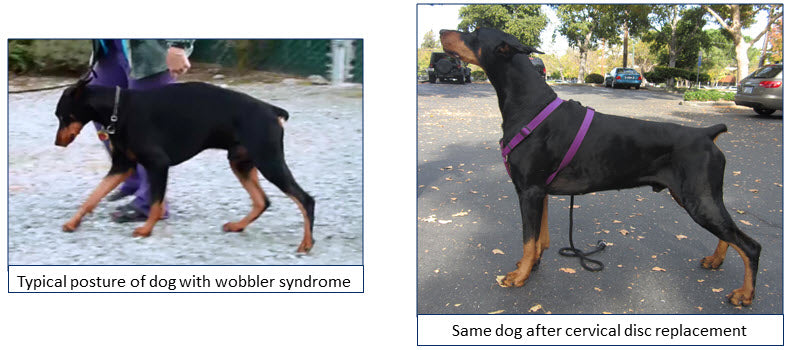Cervical Disc Replacement in Dogs
Modern medicine can do amazing things for our dogs and it gives me so much hope when I see research and development go into creating solutions that give dogs access to treatment that has proven successful in the human world. Here's a recent example. There is a painful and debilitating condition called Disc Associated Wobbler Syndrome (DAWS) that affects the cervical vertebrae and inter-vertebral discs in certain dogs resulting in cervical canal narrowing and spinal cord compression. Dogs suffering from this condition often have a wobbly gate; hence the more common name Wobbler Syndrome. 
DAWS typically affects middle age to older dogs and while this condition can impact many different breeds, studies have shown it to be most prevalent with in Great Danes and Doberman Pinschers. Surgery, which is often required to treat this condition, can be extremely invasive accompanied by a long post-operative recovery. There is also a chance that this surgery would not permanently eliminate the problem since there has been a high incidence of recurrence after surgery in other locations along the spinal cord called “domino lesions”.
Sounds terrible I know, but here is where it gets interesting; Dr. Filippo Adamo, DVM, Dipl. ECVN, Chief of Neurology/Neurosurgery with East Bay Veterinary Specialists has developed an Artificial Disc Implant called the Adamo Spinal Disc® specifically designed to cure DAWS through a procedure called Cervical Disc Replacement (CDA) or Cervical Disc Arthroplasty. CDA is currently the best available option for people with cervical disc disease, so it a major achievement that this procedure is now finally available for dogs.


Dr. Adamo explains, "The goal of CDA is to preserve intervertebral mobility while providing distraction, stability, and neural decompression. This technique has also the potential advantages of treating multiple adjacent and not adjacent disc spaces, avoiding iatrogenic spinal cord or vascular damage by use of self-retaining implant, and the titanium composition of the implant enables follow-up by MRI. While mainly used for Disc Associated Wobbler Syndrome, this procedure can be also used for the treatment of the more classic disc herniation, where the disc herniation is not combined with spinal instability. The prosthesis in this case acts as a space distractor to avoid disc space collapse, which when happens may cause compression and entrapment of the spinal nerves spinal and a source of cervical pain."
The key advantages of this procedure over common surgeries are that it is much less invasive, the recovery time is much shorter and there has been no evidence of recurrence. It can also be performed on an out-patient basis.
"After surgery the dogs are no worse than before surgery, this why the post-op hospitalization is minimal and the dogs can go home the same day after surgery. The post-operative care is also minimal, and there is no need for an external cervical brace. The implant is also self-retaining which includes less complications related to screws loosening, plate fracture or other. Six-eight weeks of post-operative activity restriction to allow bone/plate incorporation is all is needed," adds Adamo.
For more information on the Adamo Spinal Disc, please visit: wobblersyndrome.com
Ann-Marie Fleming is the Founder & CEO of Dog Quality, a provider of products focused on improving the quality of life for older dogs.

